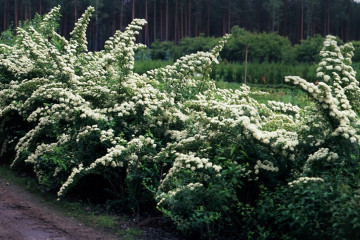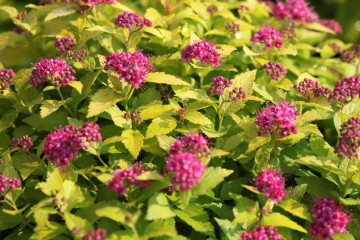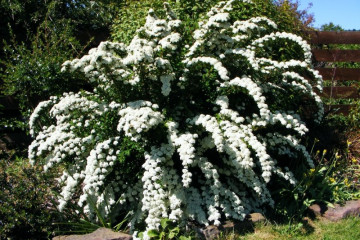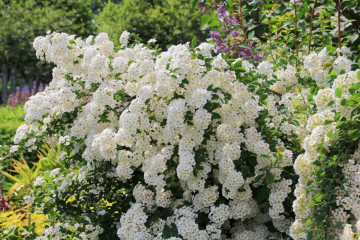Spirea Ivolistaya - care and cultivation
Content:
Among the unpretentious shrubs, willow spirea is the most winter-hardy. In nature, it grows in temperate latitudes, where in winter there are frosts down to -50 ° C. Occurs along river banks, in flood meadows on many continents.
Description of willow spirea
The botanical name "spiraea salicifolia" originated from the ancient Greek word "spiral". A deciduous shrub of the rose family, flexible, long branches. Because of the narrow foliage, the spirea began to be called willow.
Short description:
- leaves up to 11 cm long, up to 3 cm wide, smooth with short petioles, sharp-edged edges;
- the height of the bush is 1.5–2 m;
- branches glabrous, slightly faceted, yellow-green in young, reddish-brown in mature;
- inflorescences are pyramidal with a length of 12 to 25 cm or spherical with a diameter of up to 20 cm, from a distance the buds seem terry;
- small flowers with long stamens, protruding pistil;
- fruits in the form of multi-seeded leaflets are formed 45-60 days after flowering;
- the seeds are flat, brown, spontaneously pouring out of the leaflets-boxes.
Planting a plant
Species and decorative spireas (dwarf, standard) reproduce well by self-seeding. Two-year-old bushes that have reached 20 cm in height are transplanted to a new place. When weeding, it is enough to leave a few sprouted shoots. For purchased seedlings, the root system is tidied up - dried out areas are removed. The bush takes root well, it can be transplanted to a permanent place at any time of the year.
Growing from seeds
In garden plots, seeds are sown in separate areas or in boxes:
- in the spring when the snow melts;
- in the fall, immediately after the seeds have ripened.
For sowing in boxes, a mixture of rotted non-acidic peat, leafy earth is chosen. Vermiculite is added to the soil to retain moisture.
Basic Rules:
- the seeds are not deepened, only they are well moistened;
- planting material does not require preliminary preparation;
- for accelerated germination, the seeds are covered with a film for 5 days.
The picking of seedlings in thickened plantings is carried out after the appearance of 3 full-fledged leaves. The root is pinched 1/3 to activate the growth of young roots. Maintain a distance between seedlings up to 6 cm.
Note! Hybrid varieties (Arguta, Vangutta, Billard and others marked F1) are grown only from purchased seeds. In yellow-leaved, only 40% of seedlings inherit traits, varietal ones are selected when the sprouts reach 2 cm in height (green shoots drown out varietal ones). In 80% of cases, full-fledged offspring grow from the seeds of specific and decorative spirits.

In summer-blooming varieties, the color of the petals is colored, the buds retain their decorative effect until mid-autumn.
Planting seedlings in open ground
Planting of annual seedlings that have survived spring and autumn in a permanent place is carried out in spring or autumn 3 weeks before severe frosts - the plant needs to root well. It is advisable to choose open sunny areas, in shady blooms are not so abundant. The type of soil does not matter, the main thing is that the soil is neutral. A few recommendations:
- planting pits make 2 times more earthen coma;
- drainage is laid on the bottom with a layer of up to 2 cm;
- the seedling is not deeply buried.
How to care for willow spirea
Care comes down to sanitary and formative pruning, rare watering and top dressing. The shrub exists well in natural conditions, but blooms profusely when it feels cared for.
Watering
The plant is drought-resistant, young seedlings are watered on the hottest days. Old bushes need watering only in very dry years.
Important! The fibrous root system of the bush rots in stagnant water.
Top dressing
Hybrid varieties are fertilized every three years, species - when the inflorescences become smaller. Nitrogen, phosphorus-calcium fertilizers are introduced in the spring before the appearance of peduncles. Allowable dose per bucket of water:
- mullein infusion 0.5 l;
- superphosphate 10 g (half a matchbox).
Pruning
The pruning time depends on the flowering time of the shrubs:
- summer (colored) forms from the age of 4, at the very beginning of spring along a green cone;
- spring - in the fall, without touching the branches on which there were buds.
Reproduction methods
Hybrid varieties are propagated in the plots:
- pinning shoots to the ground to form a young bush;
- by cuttings, young 2-year-old shoots with darkened bark are selected;
Benefits of grafting:
- bushes bloom faster than with seed planting;
- there is less trouble with them: the cuttings are kept in water until white roots appear, after which they are planted in a permanent place.
Diseases and pests
The culture is resistant to pests and diseases. The condition of the bushes depends on the cleanliness of the site. It is also worth knowing that:
- spider mite leads to early leaf fall, damage to inflorescences;
- leafworm infects greens at the end of May;
- aphids lead to leaf curling, damage to buds.
To combat insects, drugs are used to protect vegetable and fruit crops.
Preparing for winter
The shrub winters well, only young shoots are sprinkled with mulch in late autumn. In winters with little snow, during the frost period, the trunk circle is covered with straw or spruce branches.
Use in landscape design
Of the spring flowering, the most common species is alba, with a yellow tinge of petals.
Spirea is used to make hedges, in urban landscape design they are used for landscaping squares and parks.
Healing properties
White spirea (the official name of Spiraea Alba) is used for medical purposes as an antimicrobial, antiparasitic, anesthetic.
A flowering shrub is a real find for gardeners. It does not require frequent care, the plant is unpretentious. Serves as a decoration of the site and a living pharmacy at the same time.




















